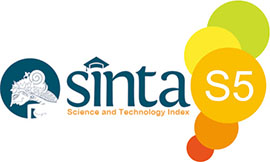5HP-Based Interactive Video Development: Creating Smart Learning Objects for Effective Learning
 ), Mario Emilzoli(2),
), Mario Emilzoli(2), (1) Universitas Pendidikan Indonesia
(2) Universitas Pendidikan Indonesia
 Corresponding Author
Corresponding Author
DOI : https://doi.org/10.24036/et.v12i2.131289
Abstract
This study aims to develop interactive learning videos based on the 5HP platform as Smart Learning Objects to enhance learning outcomes in curriculum and instrcution courses. With a growing demand for engaging and flexible digital learning tools, this research uses the research and development (R&D) method through the 4D model to ensure the systematic development of effective teaching materials. The 4D model, developed by Sivasailam Thiagarajan, Dorothy S. Semmel, and Melvyn I. Semmel, consists of four stages: Define, Design, Develop, and Disseminate, which facilitate the structured creation of diverse learning media. This study employed a pre-test and post-test design with 30 undergraduate students to assess their comprehension of curriculum development models before and after using the 5HP-based interactive video. Results show a significant improvement in students' understanding and engagement, demonstrating that interactive videos foster more effective learning. The findings suggest that 5HP-based interactive videos can potentially become valuable tools in modern educational settings, enhancing student motivation and learning outcomes.
References
Afıfy, M. K. (2020). Effect of interactive video length within e-learning environments on cognitive load, cognitive achievement and retention of learning. Turkish Online Journal of Distance Education, 21(4), 68-89.
Akbulut, Y., & Cardak, C. S. (2012). Adaptive educational hypermedia accommodating learning styles: A content analysis of publications from 2000 to 2011. Computers & Education, 58(2), 835-842.
Almara'beh, H., Amer, E. F., & Sulieman, A. (2015). The effectiveness of multimedia learning tools in education. International Journal, 5(12), 761-764.
Arfi, J., Wahyuri, A., Gusril, G., Rasyid, W., & Ockta, Y. (2024). Developing Engaging Audio-Visual Learning Media for Basic Locomotor Patterns through Play-Based Activities for Early Learners. Journal of Education, Teaching and Learning, 9(1), 40-46.
Bruce, D. L., & Chiu, M. M. (2015). Composing with new technology: Teacher reflections on learning digital video. Journal of Teacher Education, 66(3), 272-287.
Clark, R. C., & Mayer, R. E. (2023). E-learning and the science of instruction: Proven guidelines for consumers and designers of multimedia learning. john Wiley & sons.
Dabbagh, N., & Kitsantas, A. (2012). Personal Learning Environments, social media, and self-regulated learning: A natural formula for connecting formal and informal learning. The Internet and higher education, 15(1), 3-8.
Fraser, K. L., Ayres, P., & Sweller, J. (2015). Cognitive load theory for the design of medical simulations. Simulation in Healthcare, 10(5), 295-307.
Hake, R. R. (1999). Analizing Change/Gain Scores. Woodland Hills: Dept. Of Physics, Indiana University.
Haladyna, T. M., & Rodriguez, M. C. (2013). Developing and validating test items. Routledge.
Huang, R., Chen, G., Yang, J., & Loewen, J. (2013). The new shape of learning: Adapting to social changes in the information society. Reshaping learning: Frontiers of learning technology in a global context, 3-42.
Jacob, T., & Centofanti, S. (2024). Effectiveness of H5P in improving student learning outcomes in an online tertiary education setting. Journal of Computing in Higher Education, 36(2), 469-485.
López, S. R. R., Ramírez, M. T. G., & Rodríguez, I. S. R. (2021). Evaluation of the implementation of a learning object developed with H5P technology. Vivat Academia, 24(154), 1-23.
Malone, T. W., & Lepper, M. R. (2021). Making learning fun: A taxonomy of intrinsic motivations for learning. In Aptitude, learning, and instruction (pp. 223-254). Routledge.
Mayer, R. E. (2014). Incorporating motivation into multimedia learning. Learning and instruction, 29, 171-173.
Mutawa, A. M., Al Muttawa, J. A. K., & Sruthi, S. (2023). The effectiveness of using H5P for undergraduate students in the asynchronous distance learning environment. Applied Sciences, 13(8), 4983.
Nicolaou, C., Matsiola, M., & Kalliris, G. (2019). Technology-enhanced learning and teaching methodologies through audiovisual media. Education Sciences, 9(3), 196.
Noetel, M., Griffith, S., Delaney, O., Sanders, T., Parker, P., del Pozo Cruz, B., & Lonsdale, C. (2021). Video improves learning in higher education: A systematic review. Review of educational research, 91(2), 204-236.
Noutcha, M., & Kieffer, S. (2024, June). Blended Learning Based on H5P Interactive Exercises: Insights from a Case Study. In International Conference on Human-Computer Interaction (pp. 214-233). Cham: Springer Nature Switzerland.
Polat, H., & Taslibeyaz, E. (2024). Examining interactive videos in an online flipped course context. Education and Information Technologies, 29(5), 5833-5856.
Rama Devi, S., Subetha, T., Aruna Rao, S. L., & Morampudi, M. K. (2022). Enhanced learning outcomes by interactive video content—H5P in Moodle LMS. In Inventive Systems and Control: Proceedings of ICISC 2022 (pp. 189-203). Singapore: Springer Nature Singapore.
Smaldino, S. E., Lowther, D. L., & Mims, C. (2019). Instructional technology and media for learning (12th ed.). Pearson.
Subramony, D. P., Molenda, M., Betrus, A. K., & Thalheimer, W. (2014). The mythical retention chart and the corruption of Dale's cone of experience. Educational Technology, 6-16.
Susilana, R., Dewi, L., Rullyana, G., Hadiapurwa, A., & Khaerunnisa, N. (2022). Can microlearning strategy assist students’ online learning. Jurnal Cakrawala Pendidikan, 41(2), 437-451.
Susilana, R., Johan, R. C., & Rullyana, G. (2024). Pengembangan modul digital pembelajaran daring. UPI Press.
Thiagarajan, S. (1974). Instructional development for training teachers of exceptional children: A sourcebook.
Tuma, F. (2021). The use of educational technology for interactive teaching in lectures. Annals of Medicine and Surgery, 62, 231-235.
Yamamoto, G. T., Özgeldi, M., & Altun, D. (2018). Instructional developments and progress for open and equal access for learning. Open and Equal Access for Learning in School Management, 1(1), 117-143.
 Article Metrics
Article Metrics
 Abstract Views : 62 times
Abstract Views : 62 times
Refbacks
- There are currently no refbacks.





